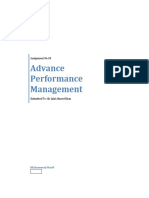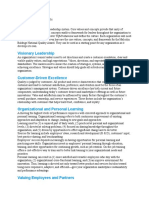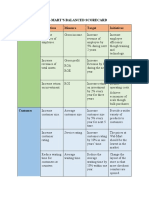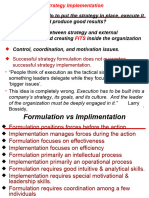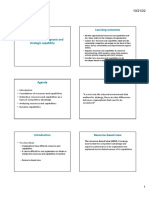B.
COM (General) C section
I Year – I Semester
Batch 2023-2026
Model Examination Practical Record
BUSINESSMANAGEMENT – UCM23102J
By
Name: S. Vaish
Register Number: RA2231201020121
DEPARTMENT OF COMMERCE
SRM INSTITUTE OF SCIENCE AND TECHNOLOGY
RAMAPURAM CAMPUS
COLLEGE OF SCIENCE AND HUMANITIES
1
� INDEX
S.NO CONTENT PAGE.NO
Case study -1 XYZ Manufacturing Company
1 3
Case study -2 The ABC Electronics Background:
2 4
Case Study-3: Sarah's Leadership Challenge
3 5
The Eco-Friendly Clothing Start-Up
4 6
Case Study 4: Enhancing Employee Coordination at
5 ABC Corporation 7
Case Study - 5: Strategic Planning at Tech Innovators
6 Inc. 8
2
�Case study -1 XYZ Manufacturing Company
Background:
XYZ Manufacturing Company is a medium-sized organization specializing in the production of
automotive components. Over the years, the company has faced challenges related to declining
product quality, increased competition, and decreasing profitability. The management team has
decided to implement strategic changes to address these issues.
Case Study Questions:
Identify the Key Issues:
Answer: The key issues at XYZ Manufacturing Company include declining product quality,
heightened competition, and decreasing profitability. These issues are negatively impacting the
company's performance and competitiveness.
Develop a Strategic Plan:
Answer: To address the identified issues, XYZ Manufacturing should develop a strategic
plan that includes:
Quality Improvement: Implementing rigorous quality control measures to ensure
consistent product quality.
Market Analysis: Conducting a thorough market analysis to identify growth opportunities
and market segments.
Cost Reduction: Exploring cost-cutting measures without compromising product quality.
Competitive Analysis: Analyzing competitors to identify strengths and weaknesses.
Innovation: Investing in research and development to introduce new, competitive
products.
Implement the Plan:
Answer: To implement the plan, the company should:
Assign responsibility for each strategic initiative to specific teams or individuals.
Allocate resources (budget, personnel, technology) as required.
Establish performance metrics and key performance indicators (KPIs) to measure
progress.
Communicate the plan throughout the organization to ensure alignment.
Evaluate Results:
Answer: After a set period, XYZ Manufacturing should evaluate the results of the
strategic plan. This involves assessing whether product quality has improved, if
profitability has increased, and if the company is better positioned in the market. Positive
outcomes should be celebrated, and any shortfalls should be addressed.
Sustainability:
Answer: To sustain success, XYZ Manufacturing should cultivate a culture of continuous
improvement, invest in employee training, and regularly update its strategic plan to
remain competitive in the long term.
Case study -2 The ABC Electronics Background:
3
�ABC Electronics is a medium-sized electronics manufacturing company known for its
innovative products. The company's management is faced with a significant decision: whether to
invest in a new, cutting-edge manufacturing technology. The new technology promises to
increase production efficiency and reduce costs, but it requires a substantial financial investment.
Case Study Questions:
Identify the Decision:
Answer: The key decision is whether ABC Electronics should invest in the new manufacturing
technology.
Decision Criteria:
Answer: The decision criteria may include:
Cost-Benefit Analysis: Assessing the financial impact of the investment, including
upfront costs, operational savings, and return on investment (ROI).
Technological Advancement: Evaluating how the new technology aligns with the
company's long-term technological goals and competitive positioning.
Market Demand: Analyzing market trends and customer demands to determine if the
investment aligns with market needs.
Risk Assessment: Identifying potential risks and uncertainties associated with the
investment, such as market changes or technology obsolescence.
Data Collection:
Answer: ABC Electronics should gather data related to the cost of the new technology,
potential operational improvements, market research on customer demand, and
assessments of potential risks.
Evaluate Alternatives:
Answer: ABC Electronics may consider alternatives, such as:
Do Nothing: Continue current operations without the new technology.
Phased Implementation: Implement the technology gradually to reduce risk.
Explore Other Technologies: Investigate alternative technologies or vendors.
Analysis and Decision:
Answer: After collecting data and evaluating alternatives, ABC Electronics should
conduct a cost-benefit analysis to determine if the benefits of the new technology
outweigh the costs. They should also consider the long-term strategic implications and
potential risks. The decision may involve a quantitative analysis, but it should also
consider qualitative factors.
4
�Case Study-3: Sarah's Leadership Challenge
Background:
Sarah is a mid-level manager at a retail company that operates several stores. She's responsible
for overseeing the operations of one of the company's busiest locations. Over the past year,
Sarah has faced several challenges, including declining employee morale, high turnover, and
inconsistent customer service. Her supervisor has asked her to address these issues and improve
overall store performance.
Case Study Questions:
Identify the Managerial Skills Required:
Answer: Sarah needs to utilize a combination of technical, human, and conceptual skills.
Technical Skills: She should have a deep understanding of the retail industry, store
operations, inventory management, and customer service.
Human Skills: Sarah needs strong interpersonal skills to motivate and manage her team
effectively, improve employee morale, and reduce turnover.
Conceptual Skills: She must think strategically to identify the root causes of the store's
issues, develop a coherent plan, and align it with the company's broader goals.
Diagnose the Issues:
Answer: Sarah should analyze the factors contributing to the problems in her store. This
might include conducting employee surveys, reviewing customer feedback, and
examining performance data to pinpoint areas of improvement.
Develop a Leadership Strategy:
Answer: Sarah should create a leadership strategy that includes:
Setting clear objectives for improving employee morale, reducing turnover, and
enhancing customer service.
Establishing a communication plan to ensure employees understand the goals and their
role in achieving them.
Implementing employee engagement initiatives, such as team-building activities and
recognition programs.
Identifying training needs and providing opportunities for skill development.
Lead and Motivate the Team:
Answer: Sarah should actively engage with her team, providing support, coaching, and
feedback. She should lead by example, demonstrating a positive attitude and a
commitment to improving store performance. Regular team meetings can foster
communication and collaboration.
Monitor Progress:Answer: Sarah should track key performance indicators (KPIs) related to
employee morale, turnover, and customer service. Regular performance reviews and feedback
sessions with employees can help gauge progress.
5
�Case Study-4: The Eco-Friendly Clothing Start-Up
John is an environmentally conscious entrepreneur who is passionate about sustainable living.
He has come up with an innovative business idea: launching an eco-friendly clothing brand
called "GreenWear." John believes that there is a growing market for sustainable fashion, and he
wants to create a brand that not only sells eco-friendly clothing but also promotes awareness
about environmental issues.
Case Study Questions: Business Idea Description:
Answer: John's business idea is to establish a sustainable clothing brand called
"GreenWear" that offers a range of eco-friendly clothing made from sustainable materials
like organic cotton, bamboo, and recycled fabrics. The brand's mission is not only to
provide high-quality, environmentally friendly clothing but also to educate consumers
about sustainable living and promote eco-consciousness.
Market Research:
Answer: John should conduct thorough market research to identify the demand for eco-
friendly clothing in his target market. This includes understanding consumer preferences,
price sensitivity, and competitors in the sustainable fashion industry.
Unique Selling Proposition (USP):
Answer: John's USP is the combination of sustainable clothing and an educational
approach. GreenWear not only offers eco-friendly products but also provides information
on sustainable living practices through its website, blog, and customer events.
Target Audience:
Answer: The target audience for GreenWear includes environmentally conscious
consumers who value sustainability and ethical fashion. This may include individuals
who support eco-friendly practices and are willing to pay a premium for sustainable
clothing.
Business Model:
Answer: John can adopt a business model that combines online sales through an e-
commerce platform with physical retail stores. Additionally, he may explore partnerships
with eco-conscious influencers and collaborations with environmental organizations to
expand brand reach.
Marketing Strategy:
Answer: John's marketing strategy should focus on educating consumers about
sustainable fashion and its impact on the environment. He can use digital marketing,
social media, and content marketing to create awareness and engage with the target
audience. Additionally, partnerships with eco-bloggers and participation in eco-friendly
events can help promote the brand.
Sustainability Practices: Answer: GreenWear should adhere to rigorous sustainability
practices, including sourcing materials responsibly, using eco-friendly dyes and processes,
minimizing waste, and ensuring fair labor practices throughout the supply chain.
6
�Case Study 5: Enhancing Employee Coordination at ABC Corporation
Background:
ABC Corporation is a large multinational company with multiple departments and offices across
the globe. In recent months, the company has experienced issues related to poor
interdepartmental coordination. This lack of coordination has resulted in project delays,
miscommunication, and decreased overall productivity. The company's leadership recognizes the
need to improve employee coordination to address these issues.
Case Study Questions:
Identify the Coordination Issue:
Answer: The primary issue at ABC Corporation is poor interdepartmental coordination,
leading to project delays and miscommunication.
Root Causes Analysis:
Answer: The lack of coordination may be attributed to various factors, including:
Inadequate communication channels between departments.
Different departments operating in silos, with limited interaction.
Lack of a clear coordination framework or designated individuals responsible for
coordination.
Differences in goals and priorities between departments.
Cordination Measures Needed:
Answer: ABC Corporation needs to implement a coordinated approach that includes:
Establishing Clear Communication Channels: Create effective communication channels
and protocols between departments to ensure that information flows smoothly.
Designating Coordination Roles: Appoint individuals or teams responsible for
coordinating efforts between departments and projects.
Shared Goals and Objectives: Ensure that departments share common goals and
objectives that align with the company's mission.
Regular Cross-Functional Meetings: Encourage regular meetings between departments to
facilitate collaboration and information sharing.
Implementation Plan:
Answer: The company should create a detailed implementation plan that includes:
Identifying individuals responsible for coordination in each department.
Developing guidelines and protocols for interdepartmental communication.
Establishing a schedule for cross-functional meetings and project reviews.
Allocating resources and budget for coordination efforts.
Monitoring and Measurement:
Answer: Implement a system for monitoring and measuring coordination efforts. This
includes tracking project timelines, communication effectiveness, and feedback from
employees. Key performance indicators (KPIs) such as project completion rates and
interdepartmental satisfaction should be monitored.
7
�Case Study - 6: Strategic Planning at Tech Innovators Inc.
Background:
Tech Innovators Inc. is a leading technology company known for its innovative products and
solutions. However, in recent years, the company has faced increasing competition and market
saturation. The executive team recognizes the need for a comprehensive strategic planning
process to maintain its competitive edge and ensure sustainable growth.
Case Study Questions:
Identify the Planning Issue:
Answer: The main issue at Tech Innovators Inc. is the need for a comprehensive strategic
planning process to address increasing competition and market saturation.
Root Causes Analysis:
Answer: The decline in market position may be attributed to factors such as:
Insufficient adaptation to changing market dynamics.
Lack of a clear long-term strategy.
Inadequate market research and customer insights.
Inefficiencies in product development and release cycles.
Planning Measures Needed:
Answer: Tech Innovators Inc. should embark on a strategic planning initiative that
includes:
Market Analysis: Conduct in-depth market research to identify emerging trends,
customer needs, and competitive threats.
Goal Alignment: Ensure that all departments and teams align their goals with the
overarching strategic objectives.
Innovation Strategy: Develop a clear innovation strategy to drive product development
and technological advancements.
Resource Allocation: Allocate resources effectively to prioritize key projects and
initiatives.
Implementation Plan:
Answer: The company should create a detailed implementation plan that includes:
Appointing a strategic planning team or hiring external consultants.
Setting a timeline for the planning process, including milestones and deadlines.
Defining key performance indicators (KPIs) to measure progress.
Establishing a budget for the planning process.
Monitoring and Measurement:
Answer: Implement a system for monitoring and measuring the progress of the strategic
planning process. This includes tracking the completion of key milestones, assessing
alignment with strategic goals, and collecting feedback from stakeholders.













